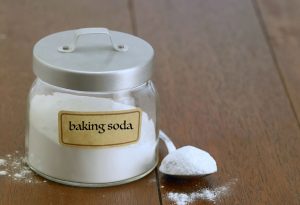What is the difference between baking powder & baking soda? That’s exactly what we are discussing here in detail. Here, we’ll check the comparison between Baking Soda vs Baking Powder.
Baking is an art; baking powder and baking soda are vital elements. Both work their magic in baked products, providing the perfect taste and texture.
But have you ever wondered the difference between baking powder & baking soda? Which one should you use? Do they have the same function? Is it possible to use them interchangeably? Is it essential to use both when a recipe specifies it?
Baking Soda vs Baking Powder
Knowing the difference between baking soda and baking powder is crucial. Both act as leavening ingredients but are different. They are used to raise baked goods by releasing carbon dioxide before they’re cooked. Baking soda is included in baking powder. However, the two compounds are utilized in distinct ways.
Let’s go through them one by one to understand and analyze their features.
What is Baking Soda?

To understand the difference between baking powder & baking soda, let’s first discuss what baking soda is. Its scientific name is Sodium Bicarbonate, represented by the formulae NaHCO3. It is a salt with a Na cation and an HCO3 anion. Simply put, baking soda is a crystal-white substance with a salty flavor. It is used as a leavening ingredient in baking, meaning it induces the foaming and softening of the mixture.
Sodium Hydrogen Carbonate is another name for it. Baking soda is used in baked goods, including cakes, muffins, and cookies.
When mixed, baking soda and vinegar result in a chemical reaction, and bubbles are formed. This process produces carbon dioxide. A similar process occurs in our biscuits, pastries, bread, cake, and other baked goods. When a recipe asks for baking soda, it typically also calls for buttermilk, yoghurt, lemon juice, vinegar, cream of tartar, honey, or apple sauce. This acid is required in the recipe because it reacts with baking soda, releasing carbon dioxide and expanding your baked product.
Properties of Baking Soda
- Non-flammable properties.
- The melting point is 50 degrees Celsius.
- Basic in its nature.
- Odourless and resembles a white crystalline solid.
Uses of Baking Soda
- Helps in controlling acidity in the stomach.
- Behaves as an antacid and is used to treat stomach pain.
- Used in washing via water softener.
- Used as fire extinguishers because it produce frothy foam.
- Acts as a pesticide to kill pests.
- It can remove dirt from clothes without harming their color and fabric.
- Found in cosmetics and other hygiene products.
- Utilized to overcome the effects of acid by serving as a neutralizer.
What is Baking Powder?

Baking powder has a leavening mechanism that produces CO2 when it comes into contact with water. Baking powders comprise baking soda and acids with which the baking soda might react. Most home chefs are probably unaware that these are divisions rather than individual elements. However, the chemicals that make up baking powder or soda can differ. Depending on the food being made, industrial food makers utilize varied compositions and particle sizes to achieve the desired results.
Single-acting baking powders demand only humidity to release gas. They can only be used if the material is to be baked shortly after mixing, much like baking soda. There are no single-acting baking powders on the market today.
Single-acting baking powder releases gas far too quickly to be practical in most applications. When double-acting baking powders are cold, they release some gas. But they require heat to complete the reaction. Cake batters created using double-acting baking powder can have the leavening ingredient added early in the blending process and then be allowed to rest before baking. The baking powder formula is NaHCO3.
Properties of Baking Powder
- White in color
- Composed of 3 components – base, acid, and filler.
- It can determine the final texture of your food.
- Effects the flavor, moisture content, and overall nutritional value.
- Baking powders generate carbon dioxide.
- Comes under 2 categories: single-acting and double-acting.
Uses of Baking Powder
- It can be used as a deodorizer in carpets and car fabrics to remove odors.
- Used as a speedster in detergents to remove bad odors in clothes while washing.
- Usually applied as a degreaser to remove stubborn stains of grease.
- Baking powder mixed with salt can act as an ant-repellant.
- Used to prevent gas issues by using a small amount of it while cooking foods that bloat your stomach.
- Help remove crayon marks by scrubbing the stain with a brush.
- A clogged drain can be removed by using baking powder with vinegar and hot water.
- Used as a Microwave cleaner to remove food stuck inside the oven.
Baking Powder vs Baking Soda: Key Points you Should Know
By now, you know what baking soda and baking powder are. It’s time to difference between baking powder vs baking soda.
- Ingredients – Baking soda constitutes only Sodium Bicarbonate while baking powder contains many elements, including baking soda and acid salts. This is perhaps the biggest difference between baking soda and cooking soda.
- Monocalcium Phosphate – Monocalcium Phosphate is absent in baking soda. On the other hand, baking powder does include monocalcium phosphate, which reacts with NaHCO3 when exposed to moisture and heat.
- Reaction with acids – Baking soda reacts quickly with acid, while baking powder takes time to react with acids.
- Leavening process – Baking soda has a short window of leavening while baking powder has an extended interval of leavening with the help of a second acid.
- Puffiness – Products from baking soda have a small amount of puffiness due to the shorter duration of the reaction. Conversely, products from baking powder have a greater puffiness due to a slower and longer period of the reaction.
Baking Soda vs Baking Powder: Head-to-Head Comparison
Here’s baking powder vs soda summed up for you.
| S.N. | Baking soda | Baking powder |
| 1. | Contains only Sodium Bicarbonate | Contains many elements, including baking soda |
| 2. | Monocalcium Phosphate is absent | Monocalcium Phosphate is present |
| 3. | Has a quick reaction with acids | Has a slow reaction with acids |
| 4. | The leavening time interval is short | The leavening time interval is slow and lengthy |
| 5. | Baking products are less fluffy | Baking products are very fluffy |
Conclusion
Baking soda and baking powder have qualities that overlap. The baking business is completely reliant on them to provide us with some delectable baked products. Apart from the food industry, they are helpful to us in our homely activities like washing clothes and removing stains or bad odour. Hopefully, this will help you get a clear picture of the difference between baking powder and baking soda.
People are also reading:




